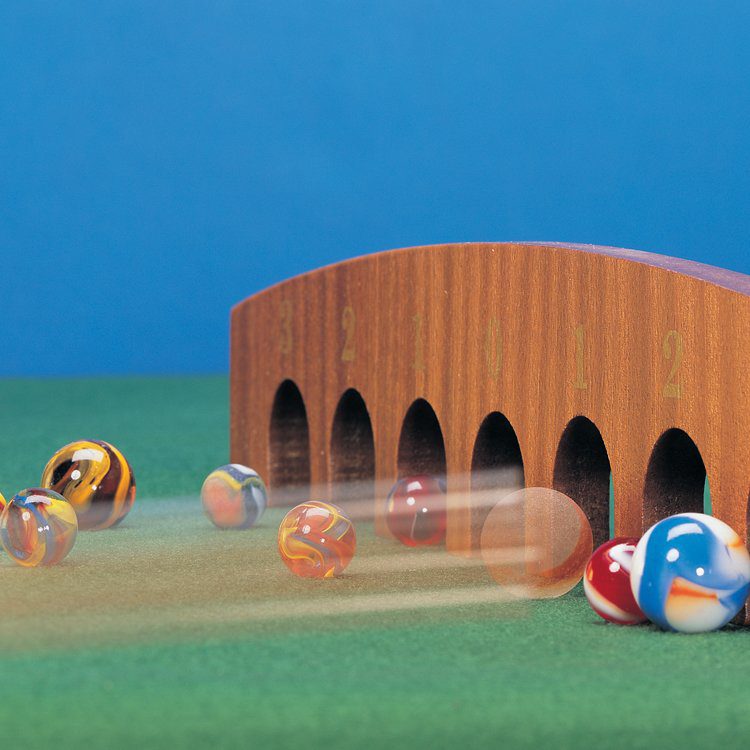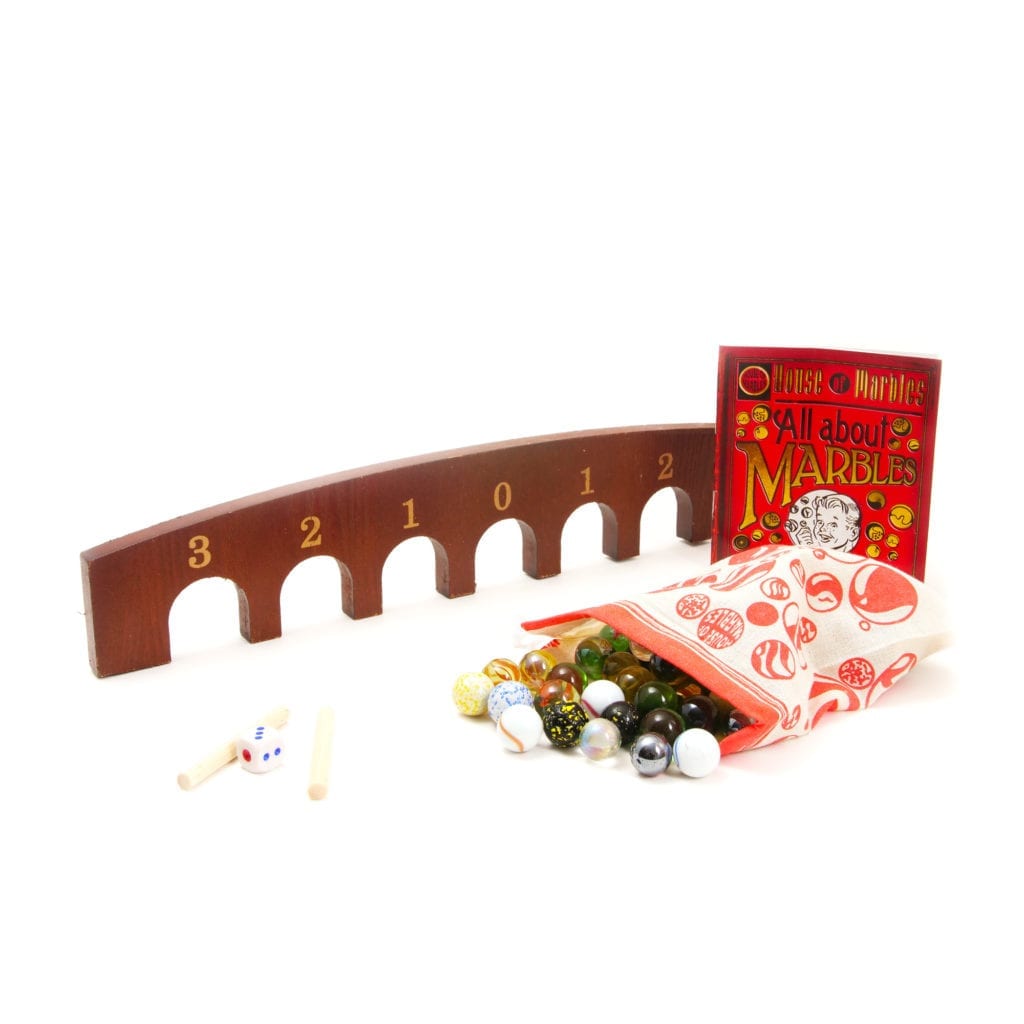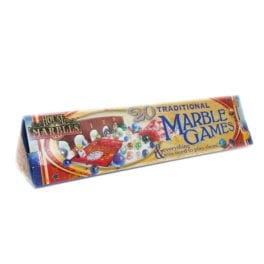

The history of marbles
The earliest marbles were made of flint and stone and baked clay. Examples have been found in archaeological sites around the world and some of these, from Rome and ancient Egypt, can be found at the British Museum.
There are frequent references to marbles in Roman literature and it is probably fair to assume that the Romans took this popular form of entertainment with them to all parts of their empire.
For centuries thereafter the marbles were made of common stone or in some cases, real marble. China and crockery marbles were introduced around the year 1800 and before that glass marbles had been made in Venice. However, it was only when a German glassblower invented a tool called the marble scissors in 1846 that production became quick enough to make the sale of glass marbles to the public an economic proposition.
These marbles became increasingly popular throughout Europe and America. An enormous variety of colours were used and intricate patterns were created within the glass.
Clay marbles began to be produced in bulk from about 1870 onwards on both sides of the Atlantic. In the 1890’s the first machines for the manufacture of glass marbles were introduced. However, machine production remained low until the 1914-18 war in Europe cut off supplies of marbles to North America. This stimulated the machine production of glass marbles in the U.S.A. This production technique and the machines themselves are now found in many countries, east and west.
A marble made of pure, ground marble or other suitable stone, is highly prized and regarded as being the most accurate for shooting. They are expensive and therefore they are rare. Conversely, clay marbles are very inexpensive, but they tend to be inaccurate in dimensions and dull in appearance and, although they were once the most common of marbles, lack of demand has made them hard to find.
These days, marbles are made from all sorts of materials, but glass remains by far the most popular. Glass lends itself to machine production and provides an article which is appealing to the eye and to the touch.
Shooting
The most common method of shooting a marble along the ground is known as “FULKING”. The knuckle of the forefinger is put on the ground and the marble balanced in the bent forefinger. The thumb is put behind the forefinger and then released with whatever force is required.
This method, however, is less accurate than “KNUCKLING DOWN” which is the method used by experts. The marble is held above the first joint of the thumb by the tip of the forefinger. The top of the thumb is held by the middle finger. The hand is kept quite still with the knuckle on the ground. The thumb is released with the required force. With practice, great accuracy may soon be obtained with this method.
Archboard (or Bridgeboard)
For this game a piece of board is required with 5 – 9 arches cut in it. The central arch is numbered 0 and the other arches increase in value to the outside of the board, i.e. 3, 2, 1, 0, 1, 2, 3.
One player is made bridge keeper, the others shoot marbles at the arches from a distance of 4’ to 5’ (1.5m). Those that fail to pass through an arch are taken by the bridge keeper. For every successful shot the bridge keeper must pay the shooter the corresponding number of marbles, the same size as the one shot, to the number written above the arch through which his marble passed. A marble passing through the centre arch marked 0 is returned to the shooter with no reward. Every player should take his turn at keeping the bridge.
Bounce about
This game, for two to four players, is played by throwing marbles and not shooting them. Medium sized marbles are best suited for the game and are called ‘BOUNCERS’.
The first player throws his bouncer forward about 5’ (1.5m). The second player throws his to try and hit it. The third player throws to try and hit either one on the ground and so on. If a bouncer is hit the owner must pay the successful thrower one marble. Bouncers are generally not forfeited.
Bounce eye
A circle 1’ (30cm) in diameter is marked on the ground. Each player puts one marble in a pool in the centre of the circle. The players take it in turns to stand over the circle and drop a marble from eye level into the pool of marbles. Any marbles knocked out of the ring become the property of the player. If a player fails to capture any marbles with a drop, that marble he has dropped remains in the pool. The game continues until the pool is dry.
Conquerer
An order of play is decided. The first player throws forward a marble to whatever distance he chooses. He will generally choose the distance at which he personally shoots with the greatest accuracy.
The next player then shoots at this marble. If he hits it he captures it and it becomes his property. He then throws out a new marble to restart the game. If he MISSES it however, his marble remains in the field. The third player then shoots at either marble, capturing whatever he hits, but leaving his marble in the field if he misses. If a marble is shot with the force and bounces off several marbles in the field, then all those hit are captured.
Die shot
A die is balanced on a marble which has been ground down slightly for stability. As in Arch board, players take it in turns to be the keeper of the die. Any player wishing to have a shot pays the keeper one marble. He then shoots it at the target from a predetermined distance. He must pay one marble for each shot he makes. If a player knocks the die off the marble with his shot, he receives from the keeper the number of marbles corresponding to the number shown uppermost on the die.
Dobblers
A game for any small number of players. Each player contributes one or more marbles to a straight line of marbles spaced so that there is room for two marbles to pass through the gaps. Each player then shoots in turn and may keep any marbles he hits. The players TAW remains where it lies at the end of his turn and subsequent turns are played from where the TAW lies. A player whose TAW is hit by another TAW must add one marble to the line. TAW is a name commonly used to describe the marble actually used by a player to shoot at other marbles.
Hundreds
A game for two players. Draw a small circle or make a small hole a suitable distance from the shooting spot. Both players shoot a marble towards the circle. If both or neither marble stops within the circle both players shoot again. If, however, only one player’s marble stops within the circle, that player scores 10 points and goes on shooting, scoring 10 points each time his marble stops in the circle. This continues until he has scored 100 or until he misses. When he misses the turn passes to his opponent who shoots and scores until he misses. The first player to reach 100 points is the winner and the loser hands over a predetermined number of marbles.
Long Taw
For two players. Each player contributes a marble and these are placed approximately 6’ (2m) apart. The players withdraw a further 6’ and the first player shoots his TAW at the first marble. If he hits it he pockets it and shoots at the second marble. If he hits that, he wins the round and the game starts again. If he fails to win the round outright the opponent shoots at the marbles and at the TAW. If the marbles are hit the result is as described for the first player. If he hits the TAW he captures whatever is on the ground.
Pyramid
As in Arch board and Die Shot, someone has to be the keeper of the pyramid. This person draws a circle approximately 30 cms (1 ft) in diameter and places one marble on top of three to form a pyramid in the centre of the ring. The keeper then charges the players a marble for each shot at the pyramid. Any marbles knocked out of the ring become the property of the shooter and the pyramid has to be rebuilt by the keeper using his own marbles.
Increase pound
A game for several players. Two circles are drawn: one circle 20 cm (8in) in diameter known as the pound and around it another of 3.5 m (11ft) diameter called the ‘bar’. Each player puts one or more marbles into the pound. The first player shoots a Taw from any point of the bar, at the marbles in the pound. Any marbles he knocks out of the pound become his property. If he fails to capture even one marble his Taw remains where it stops, if that is within that bar and outside the pound. If it stops within the pound it must be lifted and a marble paid to the pound.
Subsequent players may shoot at the pound or at an opponent’s Taw. If a Taw is struck by another Taw, the owner of the struck Taw must give any marbles he has captured so far in the game to the owner of the Taw that struck his Taw.
Ring taw
This is one of the best known and most popular of all marble games for a group of players. As with ‘INCREASE POUND’, two circles are drawn on the ground. The inner circle should be about 1’ (30cms) in diameter, the outer should be about 7’ (2m) diameter. Each player puts an agreed number of marbles into the ring. The order of play is decided and the players take turns to shoot their TAW from any point on the outer ring, at the marbles in the centre.
Any marbles knocked out of the centre ring are pocketed by the shooter and he is entitled to shoot again from the spot where his TAW lies. When a shot is unsuccessful play passes to the next player and the TAW remains on the ground where it comes to rest, if that spot is within the outer ring. The next player may then shoot at the marbles in the centre or at any of his opponents TAWS. If he strikes a TAW, the owner of that TAW has to pay him one marble and he takes another shot. The shooter may not strike the same opponents TAW twice in succession. The game continues until the ring is cleared.



